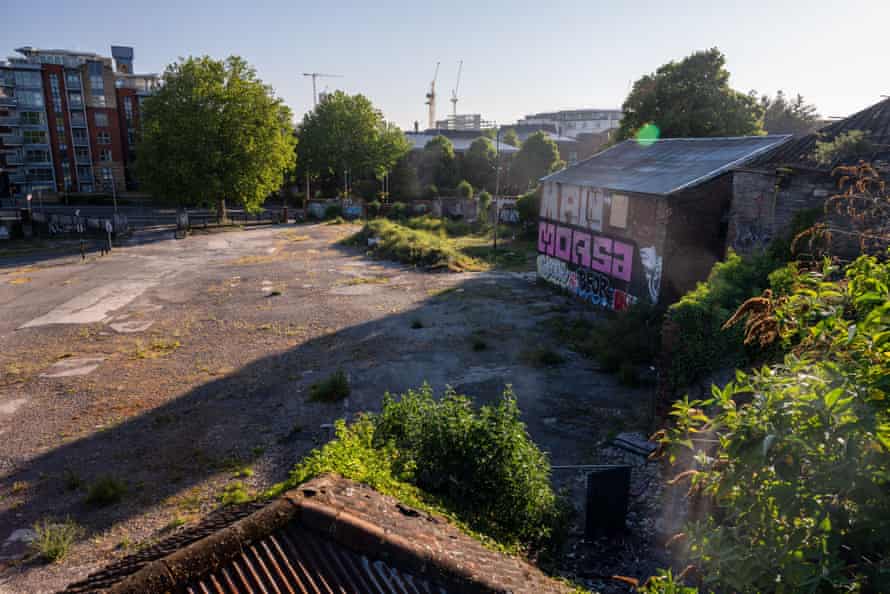One down, 39,136 to go: the explorers who walk every street in their city
You don’t really know an urban landscape until you’ve visited all of it on foot – from slums to beauty spots. Just ask the thousands of ‘every-single-streeters’

There’s no better way to soothe the soul – and get to know a town – than striding through its streets. In my 20s, heartbroken after getting dumped, all I could do was march with the tide of London’s rush hour until the city grew quiet and dark, and I was too exhausted to feel in shock any more. A little lost in my early 30s, I spent a six-week cat-sitting stint in New York compulsively plodding around Brooklyn and Manhattan listening to Townes Van Zandt. It was a strange and lonely time, but moving through an endless montage of concentrated history and humanity felt beautiful and instructive.
The pandemic has sharpened a collective appreciation of wandering our cities with fresh eyes, exploring the streets we shunned in the pre-lockdown days, when walking was merely about hurrying from A to B. Increasingly, urban adventurers are taking this pastime even further and deciding to walk or run all of the thousands of streets that make up their warts-and-all cities. There’s even a website for tracking these epic runs or walks called CityStrides, which more than 45,000 people are using. “I can’t even wrap my head around that – so many people,” says programmer James Chevalier, who runs the site as a side project and uses the open-source site OpenStreetMap for his street statistics. So far, he says, there have been 6,300 completed attempts in various cities around the world, none of which were by him. He has covered only 45% of Holyoke, Massachusetts, but to be fair, he moved there having already done 21% of his nearby home city of Easthampton.

One of those who has the satisfaction of having drawn GPS lines over every street of their city – all 6,000 in Glasgow – is secondary school teacher Michael Shanks. He lives in a block of flats with no garden and during the first lockdown, when only an hour’s daily outdoor exercise was permitted, he says: “I felt I should do something more productive with it, rather than running around the same park.” While Shanks scoured the web for ideas, up popped the celebrated trail runner Rickey Gates, who, over 45 days in 2018, ran San Francisco’s 2,237 streets, and wrote in his blog that, as well as being an excellent training incentive, the project encouraged empathy by “popping the bubbles we live in”.
When Shanks first shared his GPS running data with CityStrides to see how much ground he had already covered in 15 years of living in Glasgow, it revealed he had only seen 8% of the city. “We are all creatures of habit,” he says, “and I had done thousands of runs in the same part of the west end of the city where I live.”

He started his quest to experience the entire city by running from his home, but soon he was having to do 6 miles (10km) just to reach new streets. Next, he switched to stopping off on his work commute to cover other areas. Because he hadn’t meticulously planned his routes for maximum efficiency, he says, “I had to go back and redo little bits of streets, which was really frustrating, but I would definitely do that again because it felt freeing to run down random streets, and then see how many were ticked off at the end.” While some every-single-streeters, as they’re sometimes called, plot long linear routes, Shanks preferred to wiggle around smaller blocks each session because for him, “rather than an athletic challenge, I was more interested in exploring and learning about the history as I was going”.
The first thing he learned on this one-year, nine-month journey was how little he really knew Glasgow. “You realise individual communities make up a city – it is not one unified place,” he says. “But in another sense, you also realise how much we are all packed into quite a small place. It’s been fascinating.”
In the fairly recent past, Glasgow was cast as the murder capital of Europe, and while it still has some serious social problems, Shanks saw that things were changing. “There wasn’t anywhere that I wasn’t comfortable spending some time chatting to people,” he says, and these interactions unearthed an untold social history of the city (he is working on a book about it). This eagerness of the public to share, he suspects, was enhanced by the boredom and camaraderie prompted by the pandemic. If he ran past someone in their garden, “they were really, really keen to stop and have a chat”. One man he spoke with in Drumchapel in the north-west of the city, says Shanks, “had been moved out after slum clearances, but then the house he had been moved to was subsequently cleared because it was deemed to be inadequate housing, and then a new block was also demolished. He basically lived in the same place for 50 or 60 years but in all these different houses. Everything had changed but the community stayed the same.”

Another surprise discovery was what Shanks calls “ghost streets”, where postwar housing was demolished and nothing was built in its place, leaving street lights illuminating little but a street sign, rubble and scrub. He photographed these, as well as whatever else caught his eye. Glasgow has more green space per capita than any other European city and, naturally, Shanks loved the parks. Less so, the ubiquitous “no ball games” signs, promoting the idea, he thinks, “that children should be seen and not heard. As a teacher, I quite enjoyed taking pictures of those.”
No one is yet close to completing all 39,137 streets of Greater London, but in 2014, before CityStrides took off, Noelle Poulson from Utah in the US blazed a trail by walking every street within London’s congestion zone – about 400 miles, she says. Armed with a trusty A-Z, she was determined to become intimately acquainted with the city before her visa ran out. For her, she says, “it was a lot about chatting with people, and going into little shops that I hadn’t seen before, and taking photos and having picnics in the park and really engaging with the city.”
“It was more magical than I thought it would be,” she continues, “because I thought it’d be looking at pretty buildings and stuff but I would end up running into street sweepers and we would have a big chat and I learned about their family, or meet people in shops and learn about how they set it up. It became a lot more about a connection with the people that I was meeting.”

Discovering hidden gems in the urban landscape provided further highlights, such as a community garden in a Bermondsey alleyway called Gibbon’s Rent. “There’s a lending library there,” says Poulson. “It was very human. You see all these places where people were finding a way to make sweet little nooks and comfy places, making it their own.”
READ RELATED: Death of Rebels bikie boss dad of Richmond Tigers AFL hero Dustin Martin still a mystery
Every walk she did, she says, even in places she wasn’t immediately inspired by, had something that made it worthwhile, “like, someone had taken the time to put poetry on the wall. Around Elephant and Castle, there are a lot of council estates and many of the streets look the same, but you can still find pockets where people have put up art, or you meet an interesting person.”
She found that London had an abundance of public spaces to explore and says it’s always worth asking if you’re not sure if you’re allowed somewhere. “See what happens,” she says. “Be curious. Ask: ‘Hey, can I go up there? Can I see that thing? Can I go in this garden?’ It’s surprising how many times people say: ‘Yeah, of course.’ Or they’ll answer questions about it.” Before Poulson says this, however, she acknowledges her privilege, as a white woman.
One CityStrider who blogged about running Seattle’s entirety wrote that the achievement felt bittersweet because, “When I told one of my friends, he pointed out that – as a Black man – he could never play this game.”
Poulson, who now lives in Dili, East Timor, often encountered concern that her endeavour wasn’t safe for a woman, but she says: “I never had any incidents.”
Among the many positive responses to his blog that Shanks has received, he says he has had a few emails, mostly from women, politely pointing out that “while it’s great that I’ve been able to do this, they wouldn’t feel safe walking around some parts of Glasgow, which is a fair point”. But he also says you can get the benefits without having to be completist. “I spoke to a woman who’s now running every single street in her immediate local community,” he says. “I’ve had some really lovely emails from people saying, ‘You’ve inspired me to go for a walk in a different place. And for me, it’s that sense of adventure in the place where you live that’s so important.”
The every-single-streeters with very impressive stats deserve some credit, though. Top of the leaderboard is Berlin-based analytics consultant Denis Bafounta. He just covered 100% of his 12th city and is within the final few streets of completing many others. “I am on track to complete at least 40 towns around Berlin before the end of the year, or at least reach 99% – it is hard to know in advance if there will be inaccessible streets.” He has had to complete Schulzendorf four times in the past year because, he says, “new streets keep being built”. This can be a problem in Berlin, too, he adds. For him, the high point of his endeavour would be if he found a way to cover 100% of Berlin – he’s currently at 99.81%.

Years ago, he says he felt uneasy running near known rightwing communities. “I am Black and I run everywhere as long as it is not private property beyond any doubt, but running every street has helped me not to care about this any more … Admittedly, it is easier for me to forget about violent reactions because I live in Germany, where not too many have weapons.”
There is a strong community spirit among striders and he says he looks forward to seeing my progress. Gulp.
I don’t live too far from Bristol, but I’ve only ever met it fleetingly, swooping in for occasional events, and the city’s topography makes it confusing to navigate as a newcomer. I have decided to use CityStrides to get to know it better, and approach it in the whim-following style that Shanks employed in Glasgow – only I’ll be walking, not running.
On the freezing spring morning I start my project, I’m not feeling it at all, as I skirt a vast, roaring roundabout, wearing an inadequate jacket. I keep walking and looking, though, and everything eventually warms up. I ascend some pleasingly ancient-looking flights of steps, and creep around mysterious back alleys (I’m a sucker for a secret passage), and soon come upon a violin shop, then another, and then a shop dedicated to bows for stringed instruments.
My curiosity is piqued: I take a wildcard steep side street and end up in a blossomy park. The chime of a bell leads me to the cathedral and I’m full of the wonder of holiday-style mooching and the healthy perspective that comes from drinking in all walks of life. When I get home, I excitedly log on to CityStrides. Twenty-three streets! Out of 4,668. I know Bristol 0.48% better and I’m looking forward to doing a little celebratory dance when I reach 1%.
Source: Health & wellbeing | The Guardian





